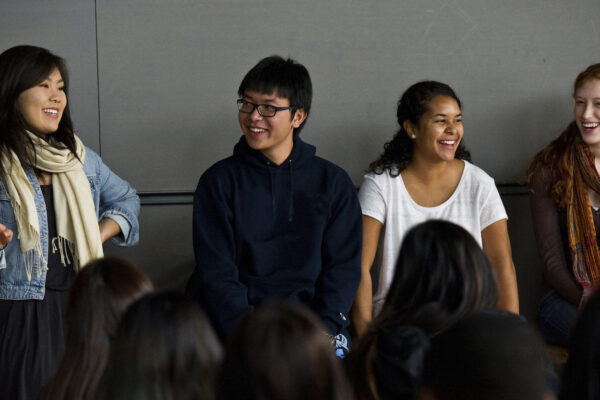Kimberly A. Griffin writes that a pathway is a better metaphor than a pipeline when considering how to diversify college and university faculty. This is the third in a series sparked by recent student protests and the national dialogue on diversity and inclusion.
Last fall, students protested on college and university campuses nationwide, demanding that institutional leaders pay attention to the challenges Black students, and students of color in general, regularly face.
While students engaged in various acts of resistance, one common strategy was to compose and deliver a list of demands to their president. One demand in particular appeared on many lists and has drawn a great deal of attention from the higher education community, the media, and others: Students want significant increases in faculty diversity, most notably, more professors from communities of color.
Increases in student diversity have not been matched in the faculty, and most campuses have small numbers of Black, Latino and Native American professors. Many leaders have struggled with how to develop strategies that will address this concern. Some institutions have dedicated significant resources and initiated action plans to increase faculty diversity on their respective campuses. However, many still struggle with developing plans and initiatives that will both produce short-term results and long-term change.
Addressing the lack of diversity we see in academia first requires a clear understanding of the root causes of the problem. As we engage in this discourse as a community, conversations and strategies often turn to the “pipeline,” or the number of students from underrepresented backgrounds entering and completing graduate programs, the prerequisite for pursuing a faculty career.
In 2014, 13 percent of doctoral degree recipients were Black, Latino or Native American, up from 8 percent in 1994. Much of this growth was due to increases in the number of Latino graduate students. While increases in the number of students completing advanced degrees has indeed been slow and attention in this area is warranted, I suggest that there are limitations to framing a lack of faculty diversity as a purely a pipeline issue.
In some ways, using a pipeline metaphor limits the way that we think about increasing diversity. David Asai, senior director of science and education programs at the Howard Hughes Medical Institute, is one of many who critique the pipeline metaphor. He explains that student access and retention, particularly for communities of color in science, are rarely linear processes. Pipeline imagery focuses our attention on one point of entry into a potential field or career—and only one possible outcome for success.
Calls for developing the faculty pipeline can make us hyper aware of how many students are entering doctoral programs. Pipeline imagery allows us to assume that if we can get more students to apply to Ph.D. programs, more will be admitted, more will finish and more will be available to enter academic careers. Although this logic seems sound, many institutions have invested a great deal of time, attention and resources in attracting student applicants, with very little change in their graduate student population. Administrators who work on graduate diversity argue that the struggle is not attracting students of color as applicants; the challenge is in whether those students are admitted. In short, focusing on recruitment and the hiring of administrators to cultivate a more diverse applicant pool will only have limited success if we do not reconsider and address how talent is identified in the admissions process.
Julie Posselt’s work on the graduate admissions process suggests that committees often embrace narrow definitions of merit, emphasizing students’ undergraduate institutions and GRE scores. Posselt and others remind us that GRE scores are inconsistent predictors of success in graduate school and emphasize that these criteria can limit the recognition of talented, high-potential students of color. Coupled with recent initiatives by the Council of Graduate Schools on holistic admission, this work pushes us to more closely attend to how we identify “rising stars” and whether the process and our criteria make it more likely that we will miss talented candidates of color.
The pipeline metaphor also creates a certain image of the progression from graduate school to an academic career. A pipeline conjures a picture of a straight line from enrollment, through graduate school, ending at a faculty position. However, a faculty career is not a given, and students’ level of interest in being professors appears to decline throughout graduate school. While it is important to honor individual agency and people choosing to align their work and their values, it is also important to note that patterns of departure from the academy aren’t the same across all groups.
Our study of 1,500 biomedical scientists suggests that underrepresented minority trainees tended to have lower levels of interest in pursuing a faculty career at a research university than White and Asian trainees, even when they reported the same level of interest when starting graduate school, time to degree, quality and quantity of publications, and perceived advisor support, which were all variables measured in our study. This trend was particularly noticeable for women, who reported the lowest levels of interest in faculty careers at research universities and the highest levels of interest in pursuing non-academic careers. Our current research aims to explain why these patterns emerge, and how people of color experience their training and make decisions about leaving the academy.
Rather than focusing solely on increasing the number of people applying to or completing graduate programs, we must see increasing faculty diversity as a multi-step process that involves both institutional-level and systemic change. If we imagine a pathway to a faculty career instead of a pipeline, multiple opportunities for intervention present themselves.
Understanding that recruitment includes encouraging applications, admissions and enrollment allows institutional leaders to develop new programs and policies that recognize prospective student talent. Also, a deeper understanding of the messages we send students about what it means to be a professor and what faculty life is like, as well as whether they “fit” into the academy, can lead to policies and programs that encourage students of color to reconsider faculty careers.
Our research suggests the desire to support underserved communities, discover concrete solutions to complex social problems, and develop the next generation of scholars of color appears central to the career aspirations of many women and people of color. Determining how these commitments can be incorporated into the values and reward structures of the academy would likely increase these students’ interests in faculty careers. These strategies begin to shift our focus from providing more scholars from diverse backgrounds with a potential opportunity to pursue a faculty career to actively cultivating talent and encouraging talented trainees to become professors. While there are no quick fixes, incorporating interventions that more directly address graduate student recruitment and training can accelerate our progress toward greater diversity and equity in the academy.
If you have any questions or comments about this blog post, please contact us.


